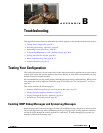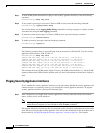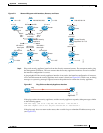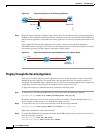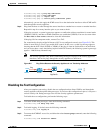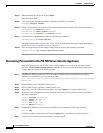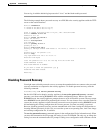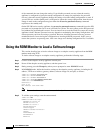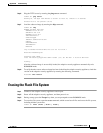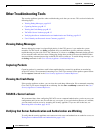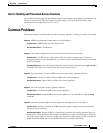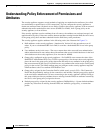
B-9
Cisco ASDM User Guide
OL-16647-01
Appendix B Troubleshooting
Performing Password Recovery
You can log in with the default login password of “cisco” and the blank enable password.
The following example shows password recovery on a PIX 500 series security appliance with the TFTP
server on the outside interface:
monitor> interface 0
0: i8255X @ PCI(bus:0 dev:13 irq:10)
1: i8255X @ PCI(bus:0 dev:14 irq:7 )
Using 0: i82559 @ PCI(bus:0 dev:13 irq:10), MAC: 0050.54ff.82b9
monitor> address 10.21.1.99
address 10.21.1.99
monitor> server 172.18.125.3
server 172.18.125.3
monitor> file np70.bin
file np52.bin
monitor> gateway 10.21.1.1
gateway 10.21.1.1
monitor> ping 172.18.125.3
Sending 5, 100-byte 0xf8d3 ICMP Echoes to 172.18.125.3, timeout is 4 seconds:
!!!!!
Success rate is 100 percent (5/5)
monitor> tftp
tftp np52.bin@172.18.125.3 via 10.21.1.1
Received 73728 bytes
Cisco PIX password tool (4.0) #0: Tue Aug 22 23:22:19 PDT 2005
Flash=i28F640J5 @ 0x300
BIOS Flash=AT29C257 @ 0xd8000
Do you wish to erase the passwords? [yn] y
Passwords have been erased.
Rebooting....
Disabling Password Recovery
You might want to disable password recovery to ensure that unauthorized users cannot use the password
recovery mechanism to compromise the security appliance. To disable password recovery, enter the
following command:
hostname(config)# no service password-recovery
On the ASA 5500 series adaptive security appliance, the no service password-recovery command
prevents a user from entering ROMMON mode with the configuration intact. When a user enters
ROMMON mode, the security appliance prompts the user to erase all Flash file systems. The user cannot
enter ROMMON mode without first performing this erasure. If a user chooses not to erase the Flash file
system, the security appliance reloads. Because password recovery depends on using ROMMON mode
and maintaining the existing configuration, this erasure prevents you from recovering a password.
However, disabling password recovery prevents unauthorized users from viewing the configuration or
inserting different passwords. In this case, to restore the system to an operating state, load a new image
and a backup configuration file, if available.
The service password-recovery command appears in the configuration file for information only. When
you enter the command at the CLI prompt, the setting is saved in NVRAM. The only way to change the
setting is to enter the command at the CLI prompt. Loading a new configuration with a different version



